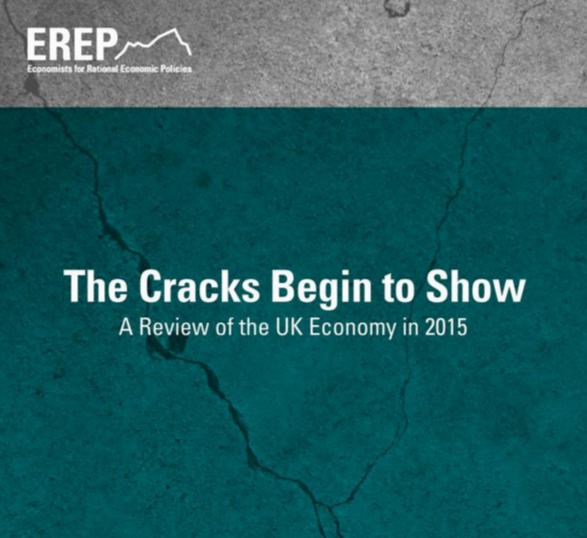
This is the Foreword to the EREP review of the UK economy 2015, “the Cracks Begin to Show”, published on 29th December. The full report can be downloaded here.
The year 2015 has repeatedly disappointed those who had high expectations that the UK economy was back to “normal times” and destined to see significant continued economic “growth.” At the start of the year, there was a general expectation that inflation would start to rise after the sudden fall in oil prices, and that the Bank of England’s Monetary Policy Committee would start, gently, the process of raising interest rates as “slack” in the economy disappeared.
In reality, and despite some positive results (the number of those in some form of employment, for example) those expectations have gently deflated as 2015 progressed. Most economists had forecast annual GDP increase of over 2.5%. The most recent ONS estimates, up to Q3, show a continuing slide in the annual rate of change per quarter. The annual rate of real GDP change in 2014 per Quarter was 2.8%, 3%, 2.8% and 2.8%. But in 2015, a series of steps down:
Q1 2.5%
Q2 2.3%
Q3 2.1%
More worryingly still, the rate of change in nominal GDP (i.e. current prices) in Q3 was also 2.1% – it is exceptionally rare for nominal GDP not to be greater than real GDP, and besides being an indicator of deflation, has a negative impact on the government finances. Indeed, we saw in the October and November public finance figures some evidence that tax receipts have slowed since the summer, with VAT in November being just 0.8% greater than in November 2014. This may make achievement of the government’s borrowing target for 2015/16 (£73.5 billion) difficult to achieve.
These recent GDP and public finance figures were published just before Christmas – and just a few weeks after the November Autumn Statement and Spending Review. The Office for Budget Responsibility had – thanks to some assumptions on GDP and tax receipts that were queried by many as being over-optimistic – helped the Chancellor to sidestep short-term political problems over working tax credit by allowing a slower path to his promised budget surplus. Those OBR and government assumptions now suffer from considerable scepticism.
Not only has GDP decelerated, but its composition has continued to disappoint. There is almost no sign of the promised “rebalancing” towards “the makers” and “the builders”. While several service industries, including real estate and food and hotels, have fared relatively well, manufacturing has seen a decline, while overall industrial production has only marginally increased over the year:
Manufacturing annual change per quarter:
Q1 1.2%
Q2 0.1%
Q3 -0.9%
Industrial production, with help from a UK oil industry increasing output (but at far lower prices) has risen between 1% and 1.4% year on year, while construction – after a strong rate of annual increase in 2014, fell back from an annual rate of 6.4% in Q1 to a very modest 1% in Q3.
This imbalance is also to be seen in the UK trade and current account statistics, both of which continue to show major deficits. The current account deficit was £17.5 billion in Q3, the same as in Q2 – leaving a deficit of 3.7% of GDP. The total trade deficit widened to £8.7 billion in Q3, from £4.7 billion in Q2, with our trade in goods worsening.
Inflation, if that is the right word, remains close to zero, with some months just above (0.1% in November), and some just below. This is due not only to the continuing fall in oil prices, but to the steady fall in all commodity prices, which indicates a wider and deeper basis for sustained deflationary pressure (at least in all manufactured goods).
The economy is far short of reaching the 2% inflation target set for the Bank of England by the government, and in part explains why UK Bank-set interest rates – unlike in the US – seem likely not to rise for some time yet. But equally important, the rise in wages which earlier in the year looked as though it might top 3% per annum, meaning a real terms pay increase at last, has recently abated, with the last two months (September and October) only showing annual rises of around 2%. The only main exception is pay in construction, which is over 6% up on the year.
Despite the increase in those in some form of employment (as employee or self-employed), the wage pressures are far from strong, and real wages remain far below their peak in 2008. This trend to lower pay has weakened demand and productivity. Whilst commodity and producer deflation have enabled shoppers to buy more goods for the same money, it is notable that people are not spending much more. On the contrary, in recent months, we have seen unsecured private debt mounting, as people once again resort to borrowing to get by.
The other side of the coin is asset inflation. The reluctance of the private sector to invest in non-speculative assets, combined with QE providing liquidity for the wealthy, together help propel a property price boom which the government has done much to promote with state-aided Help to Buy and similar schemes to increase property prices.
So indeed, as the year has progressed, the economy has slowed and regressed. The public finances are built on hopes and assumptions that appear to be fragile indeed, and economic activity in many key areas has decelerated whilst the property boom helps the asset-rich. The weaknesses in the UK economy are more and more apparent, like a building with a flashy design but poor construction. The cracks begin to show. Let’s hope there’s no earthquake coming…





